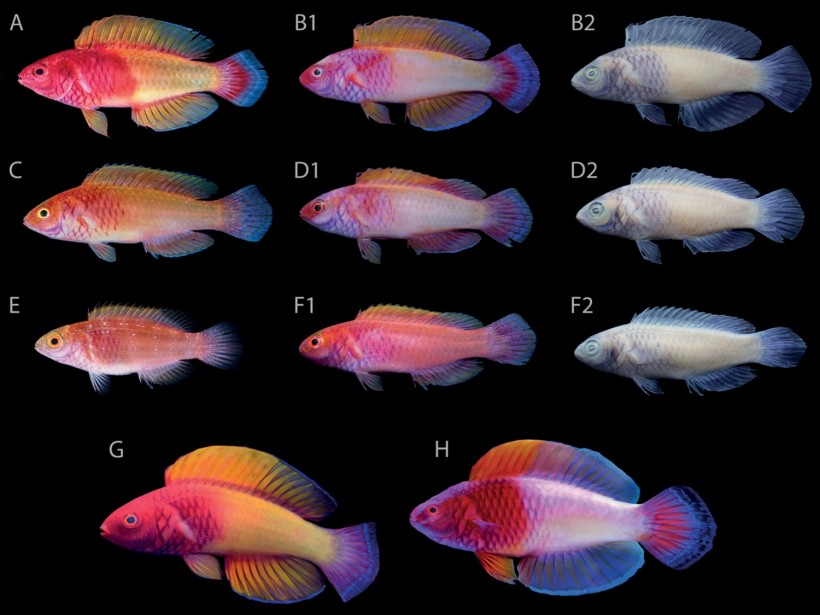The Maldives is a paradise containing a wide range of biodiversity. In a new study, experts stumbled upon a different species of fish. The swimmer contains unique physiology that separates it from the rest.
Rose-Veiled Fairy Wrasse: Cirrhilabrus finifenmaa

Cirrhilabrus finifenmaa, sp. nov., not to scale A male holotype, BPBM 33094, 69.2 mm SL, Vilingili Island, North Malé Atoll, Maldives B1, B2 male paratype, AMS I.50058-001, 69.1 mm SL, Hulhumalé Island, North Malé Atoll, Maldives, in life and preservation respectively C young male paratype, BPBM 41385 (formerly BPBM 33094), 57.6 mm SL, same data as holotype D1, D2 young male paratype, AMS I.50058-001, 59.7 mm SL, Hulhumalé Island, North Malé Atoll, Maldives, in life and preservation respectively E juvenile paratype, BPBM 41385 (formerly BPBM 33094), 35.8 mm SL, same data as holotype F1, F2 female paratype, AMS I.50058-001, 54.0 mm SL, Hulhumalé Island, North Malé Atoll, Maldives, in life and preservation respectively G male paratype in life, ZRC 62259, 76.7 mm SL, aquarium specimen from Maldives H male in nuptial colors, aquarium specimen from the Maldives, specimen not retained. Photographs by the late JE Randall (A, C, E), AN (B1–B2, D1–D2, F1–F2), and YKT (G, H).
The new species of fish was named Cirrhilabrus finifenmaa. Also called the 'Rose-Veiled Fairy Wrasse,' the animal was the first in the region with a label inspired by the local Dhivehi language.
The fish's species 'finifenmaa,' which translates to 'rose,' was chosen on purpose by the experts due to its stunning pink hue and the country's national flower.
The discovery of this previously unencountered fish was made possible through the collaborative efforts of scholars from Maldives Marine Research Institute (MMRI), the University of Syndey, the California Academy of Sciences, and the Field Museum.
The latest research on the new Maldives fish was carried out under the larger initiative of Hope for Reefs, which aims to study and protect coral reefs scattered across the world's water.
Maldives Marine Research Institute biology expert and co-author of the study Ahmed Najeeb explained that new species discovered in the region of Maldives were always conducted by foreign groups and were being processed without any involvement of the country's local experts.
This paper served as an opportunity for the Maldives scientists to rediscover the nameless creatures of the country by themselves and work alongside prestigious institutes to meet the region's beautiful creatures.
New Wrasse Species NOT a Cirrhilabrus rubrisquamis
The Cirrhilabrus finifenmaa was initially encountered by a separate team of experts back in the 1990s. However, the fish was described as an adult variant of a distinct species called Cirrhilabrus rubrisquamis.
Cirrhilabrus rubrisquamis is an entirely different creature commonly found in the Chagos Archipelago. The habitat of this fish is located in a group of islands south of the Maldives, with a distance of about 1,000 kilometers from the country.
The latest research carried out a comprehensive analysis on Cirrhilabrus finifenmaa based on the aspects that the previous team failed to acknowledge.
EurekAlert reported that the authors included several factors that make the new fish species stand out from other wrasses, including their physiology, variance of color relative to gender, scales, as well as their genetic information. The consolidated results were then compared to the Cirrhilabrus rubrisquamis.
University of Sydney expert and lead author of the paper Yi-Kai Tea said that the two Cirrhilabrus were separate species contrary to what the scientific community previously thought.
The study demonstrates how the analysis of new species and their taxonomy is essential for the biodiversity and conservation of animals, the expert added.
Prior to the rediscovery of the Rose-Veiled Fairy Wrasse, the fish were already victims of exploitation by illegal trades and lifeless hobbyists.
The study was published in the journal ZooKeys, titled "Cirrhilabrus finifenmaa (Teleostei, Labridae), a new species of fairy wrasse from the Maldives, with comments on the taxonomic identity of C. rubrisquamis and C. wakanda."
RELATED ARTICLE: Bambootula: Never Before Seen Tarantula Discovered in High Forests of Thailand by Wildlife YouTuber
Check out more news and information on Biology in Science Times.














